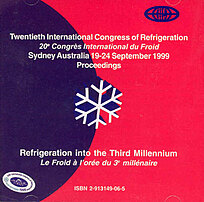
IIR document
Gel-forming ability is a sensitive indicator of quality in muscle foods.
Author(s) : MCDONALD G. A., LANIER T. C.
Summary
Texture deterioration during chilled and frozen storage considerably affects the quality and, consequently, value of muscle foods. The authors found that gel fracture properties, as measured by the fundamental torsion method, relate well to quality changes in chilled and frozen muscle foods. The true shear strain at fracture (i.e., gel deformability) correlates well with sensory cohesiveness, while shear stress at fracture relates to sensory hardness. The shear strain value is particularly useful as it is strongly influenced by quality changes due to denaturation or proteolysis of the myofibrillar proteins and also correlates well with other established objective chemical and rheological methods. The homogenisation process involved in comminuting tissue to make heat-set gels overcomes the key problem of heterogeneity of muscle tissue, which limits other rheological quality methods. The fundamental nature of the torsion method makes it ideally suited for developing quantitative quality models. Gel-forming ability is a sensitive quality method that can be used in a wide range of applications; for following texture degradation in early postmortem chilled fish, during extended chilled fish storage studies, for developing kinetic models from frozen storage studies and for understanding the interactions of cryoprotectant additives for extending frozen shelf life of fish and meat.
Available documents
Format PDF
Available
Public price
20 €
Member price*
Free
* Best rate depending on membership category (see the detailed benefits of individual and corporate memberships).
Details
- Original title: Gel-forming ability is a sensitive indicator of quality in muscle foods.
- Record ID : 2000-1468
- Languages: English
- Source: 20th International Congress of Refrigeration: Refrigeration into the Third Millennium.
- Publication date: 1999/09/19
Links
See other articles from the proceedings (447)
See the conference proceedings
Indexing
-
Themes:
Food quality and safety. Microbiology;
Meat and meat products - Keywords: Chilled food; Meat; Deterioration; Texture; Frozen food
-
EFFECT OF FROZEN STORAGE OF BOVINE PSOAS MUSCLE...
- Author(s) : HENAHAN M., MCGRATH A., HARRINGTON M. G.
- Date : 1981/08/24
- Languages : English
View record
-
Pathogen combat: a pan-European approach to imp...
- Author(s) : BRAUN S.
- Date : 2008/10/15
- Languages : English
- Source: Projektowanie i eksploatacja przyjaznych srodowisku systemów chlodniczych i klimatyzacyjnych. Miedzynarodowa konferencja. XL Dni chlodnictwa.
- Formats : PDF
View record
-
P-nitroaniline test: a rapid method for assessi...
- Author(s) : ORDÓÑEZ J. A., GARCÍA DE FERNANDO G. D.
- Date : 1996
- Languages : English
- Source: Factors affecting the microbial quality of meat. 4. Microbial methods for the meat industry. Concerted Action CT94-1456.
View record
-
Chilled transport and storage of fish: applicat...
- Author(s) : ROSS T., MCMEEKIN T. A.
- Date : 1997/06/16
- Languages : English
- Source: Predictive Microbiology Applied to Chilled Foods Preservation
- Formats : PDF
View record
-
EFFECT OF BACTERIOPHAGES ON THE COLOUR AND DISP...
- Author(s) : GREER G. G.
- Date : 1986/09/10
- Languages : English
- Formats : PDF
View record
